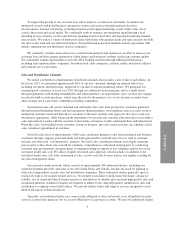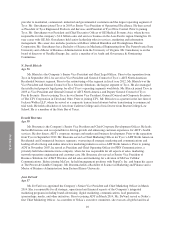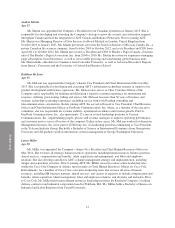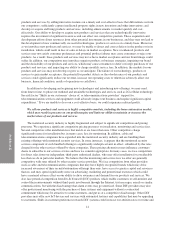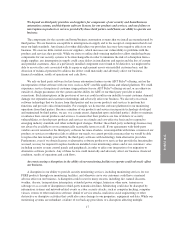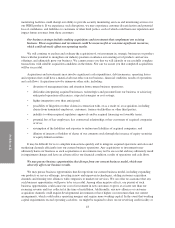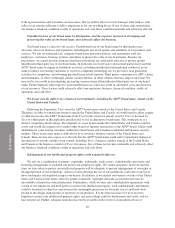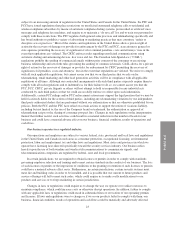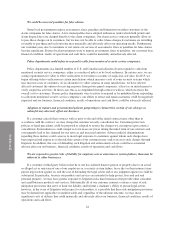ADT 2015 Annual Report Download - page 88
Download and view the complete annual report
Please find page 88 of the 2015 ADT annual report below. You can navigate through the pages in the report by either clicking on the pages listed below, or by using the keyword search tool below to find specific information within the annual report.
FORM 10-K
products and services by adding innovative features on a timely and cost-effective basis that differentiate us from
our competitors; sufficiently capture intellectual property rights in new inventions and other innovations; and
develop or acquire and bring products and services, including enhancements, to market quickly and cost-
effectively. Our ability to develop or acquire new products and services that are technologically innovative
requires the investment of significant resources and can affect our competitive position. These acquisition and
development efforts divert resources from other potential investments in our businesses, and they may not lead to
the development of new commercially successful technologies, products or services on a timely basis. Moreover,
as we introduce new products and services, we may be unable to detect and correct defects in the product or in its
installation, which could result in loss of sales or delays in market acceptance. New or enhanced products and
services may not satisfy consumer preferences and potential product failures may cause consumers to reject our
products. As a result, these products and services may not achieve market acceptance and our brand image could
suffer. In addition, our competitors may introduce superior products or business strategies, impairing our brand
and the desirability of our products and services, which may cause consumers to defer or forego purchases of our
products and services, and impacting our ability to charge monthly service fees. In addition, the markets for our
products and services may not develop or grow as we anticipate. The failure of our technology, products or
services to gain market acceptance, the potential for product defects or the obsolescence of our products and
services could significantly reduce our revenue, increase our operating costs or otherwise adversely affect our
business, financial condition, results of operations or cash flows.
In addition to developing and acquiring new technologies and introducing new offerings, we may need,
from time to time, to phase out outdated and unsuitable technologies and services such as 2G cellular technology.
See risk factor “Shifts in our customers’ choice of, or telecommunications providers’ support for,
telecommunications services and equipment could adversely impact our business and require significant capital
expenditures.” If we are unable to do so on a cost-effective basis, we could experience reduced profits.
We sell our products and services in highly competitive markets, including the home automation market,
which may result in pressure on our profit margins and limit our ability to maintain or increase the
market share of our products and services.
The monitored security industry is highly fragmented and subject to significant competition and pricing
pressures. We experience significant competitive pricing pressures on installation, monitoring and service fees.
Several competitors offer installation fees that match or are lower than ours. Other competitors charge
significantly more for installation but, in many cases, less for monitoring. In addition, cable and
telecommunications companies have expanded into the monitored security industry and are bundling their
existing offerings with monitored security services. In some instances, it appears that the monitored security
services component of such bundled offerings is significantly underpriced and, in effect, subsidized by the rates
charged for the other services offered by these companies. These pricing alternatives may influence customers’
desire to subscribe to our services at rates and fees we consider appropriate. In many cases, we face competition
for direct sales from our independent, third-party authorized dealers, who may offer installation for considerably
less than we do in particular markets. We believe that the monitoring and service fees we offer are generally
competitive with rates offered by other security service providers. We face competition from other providers
such as cable and telecommunications companies that may have highly recognized brands which may drive
increased awareness of their security/automation offerings than ours, have access to greater capital and resources
than us, and may spend significantly more on advertising, marketing and promotional resources which could
have a material adverse effect on our ability to drive awareness and demand for our products and services. We
also face potential competition from Do-It-Yourself (DIY) products which enable customers to self-monitor and
control their environments without third-party involvement through the Internet, text messages, emails or similar
communications, but with the disadvantage that alarm events may go unnoticed. Some DIY providers may also
offer professional monitoring with the purchase of their systems and equipment without a contractual
commitment which may be attractive to some customers, and put us at a competitive disadvantage. Other DIY
providers may offer new IoT devices and services with automated features and capabilities that may be appealing
to customers. Shifts in customer preferences towards DIY systems could increase our attrition rates over time and
14



